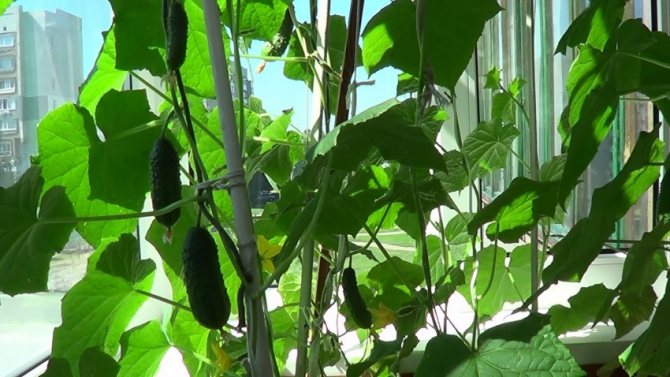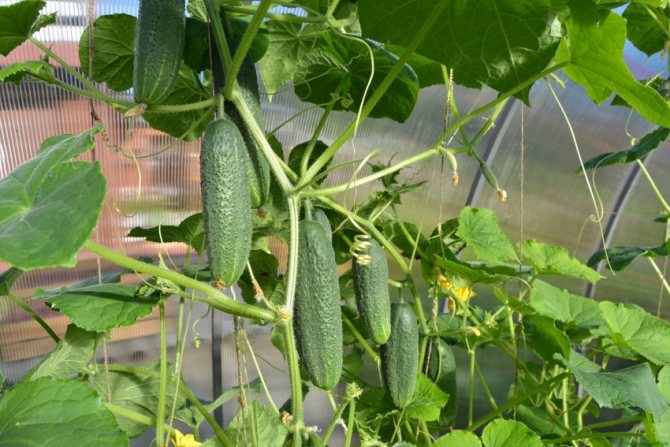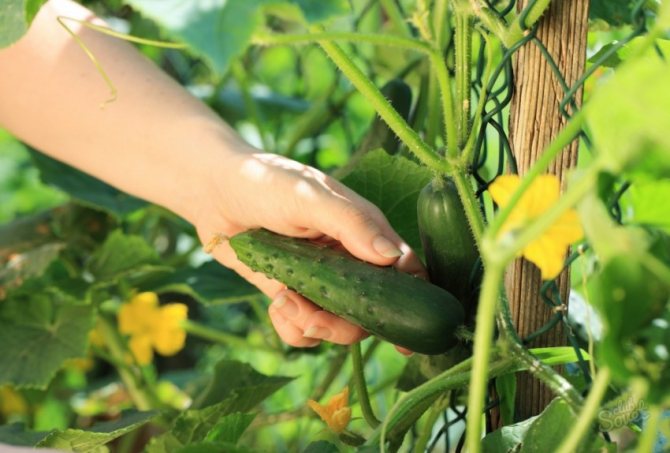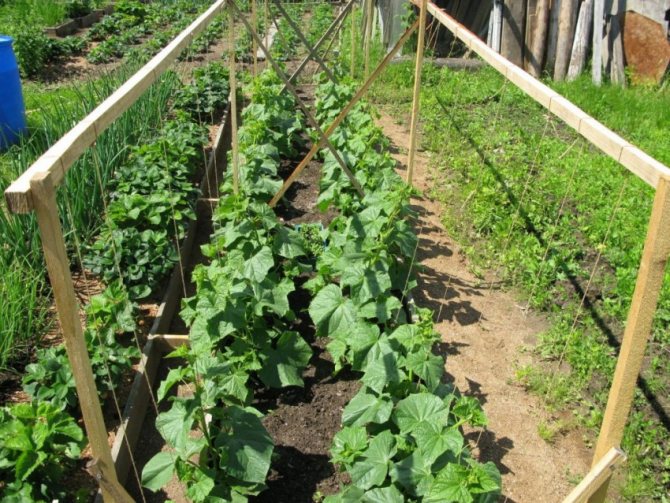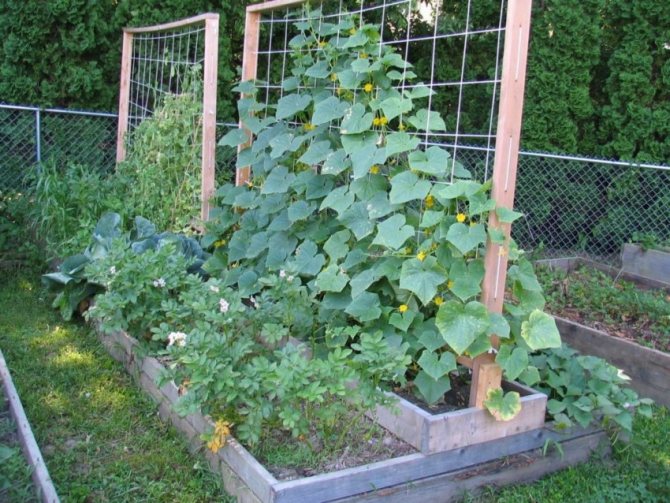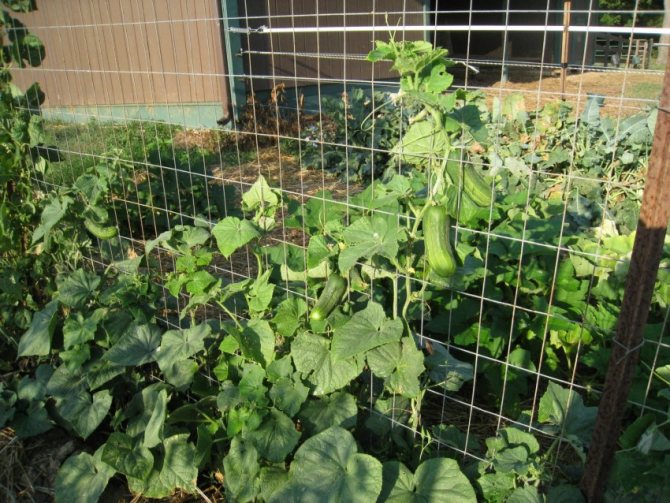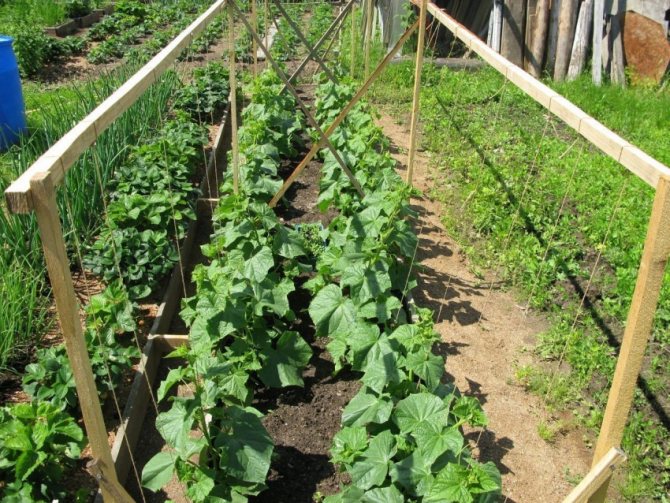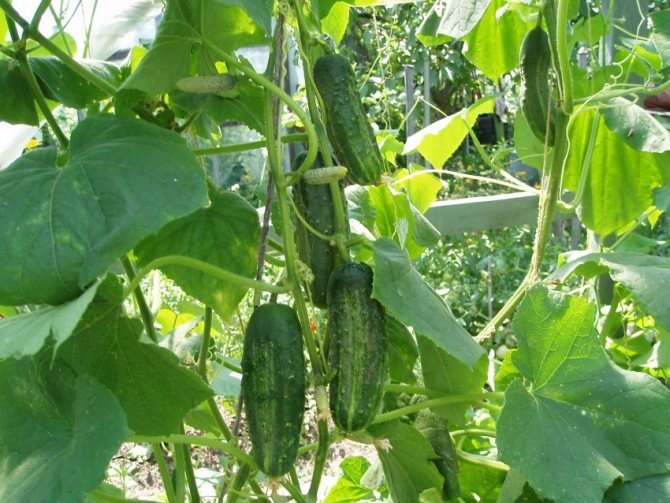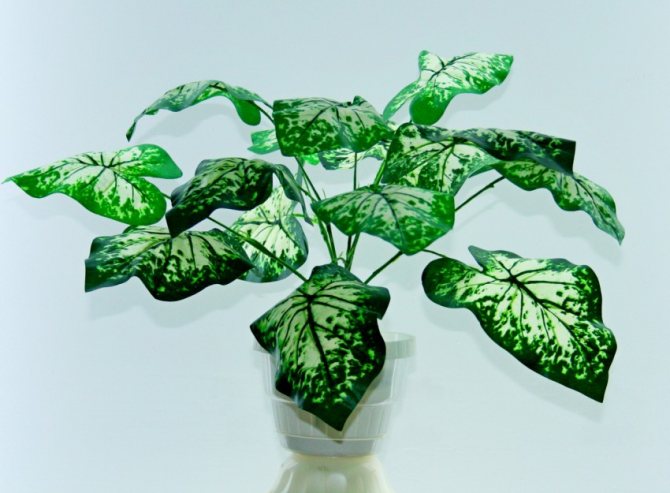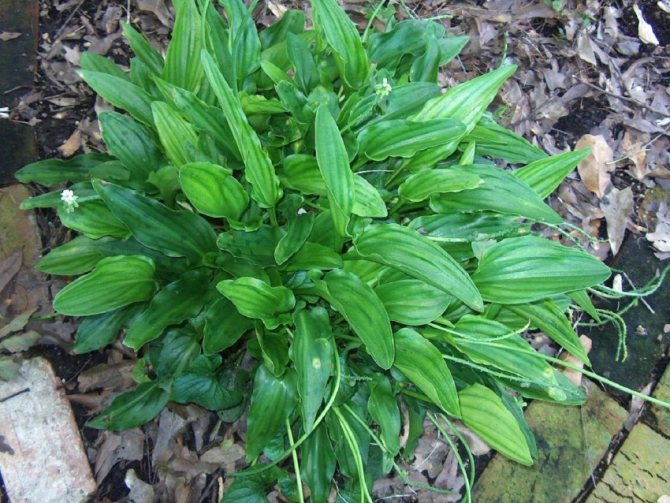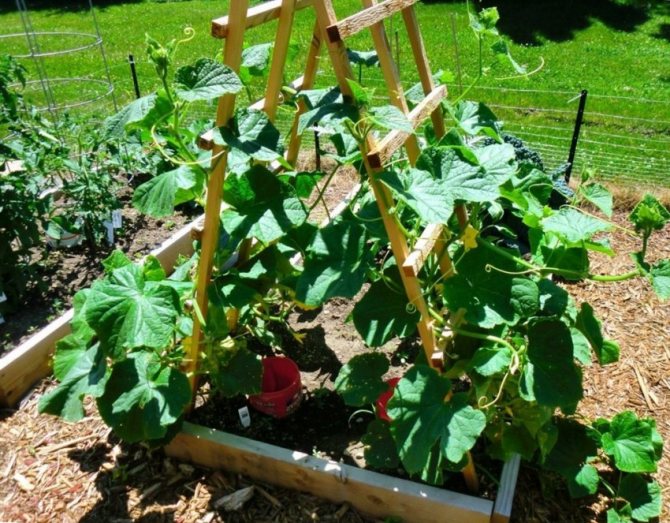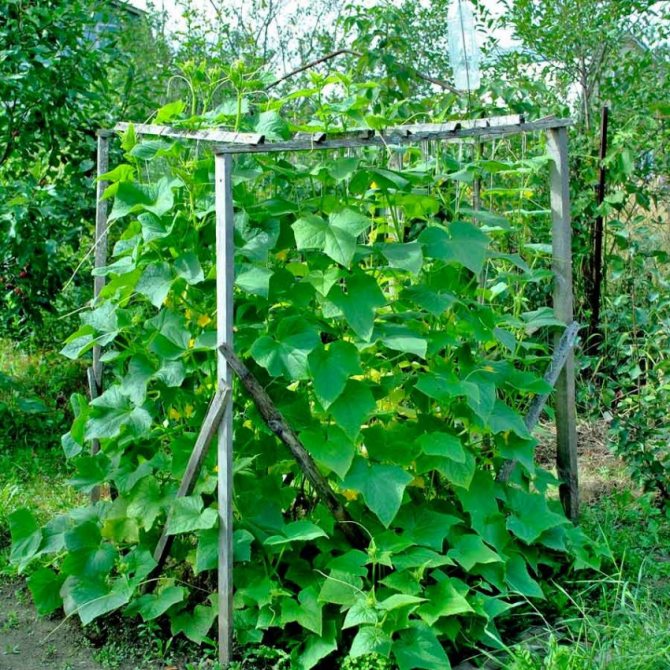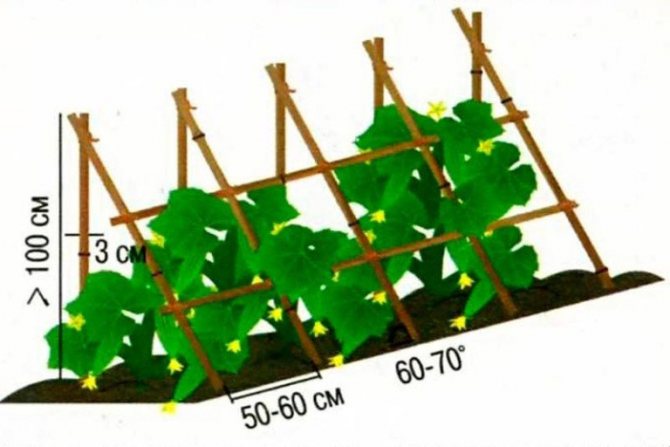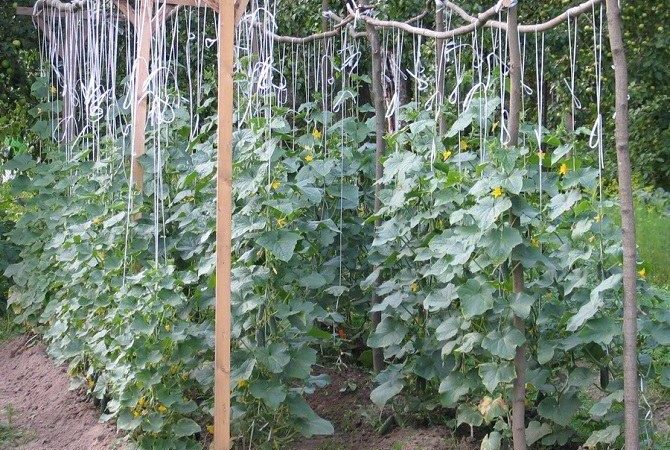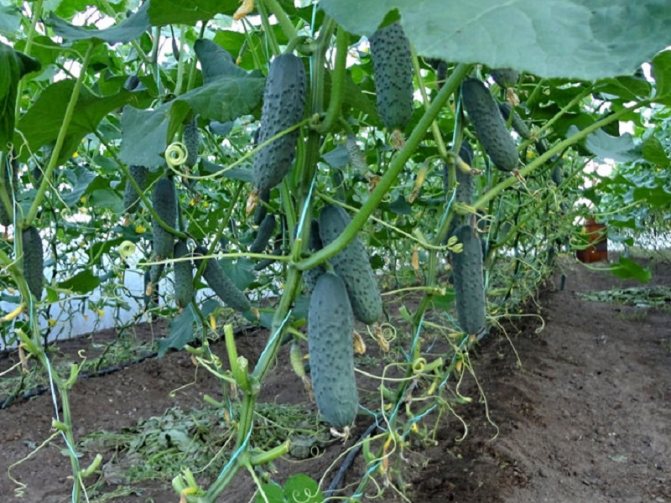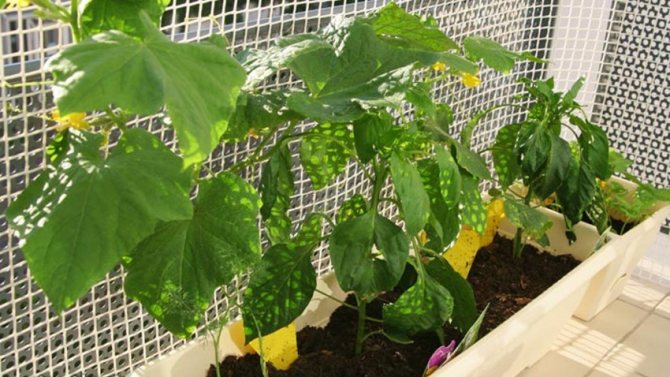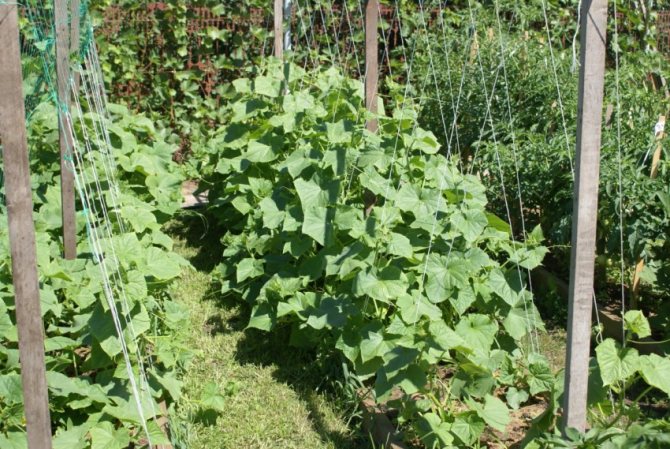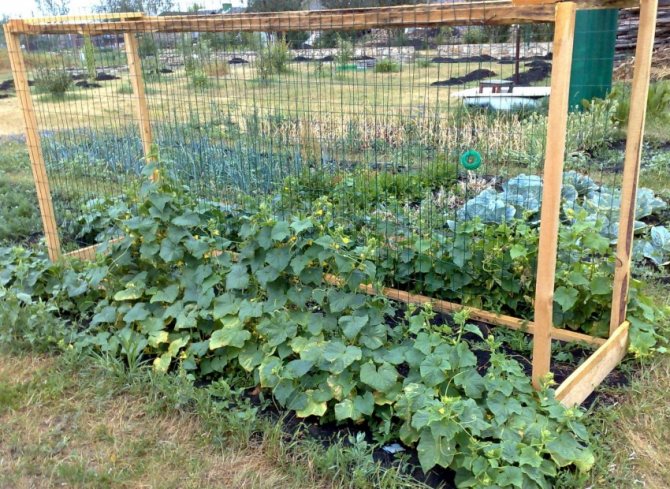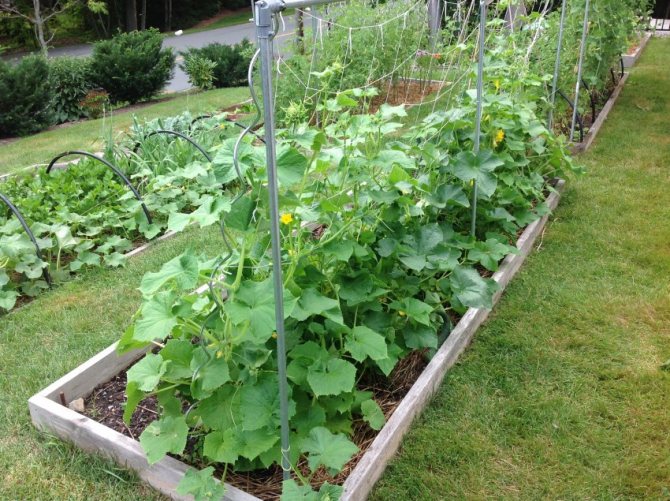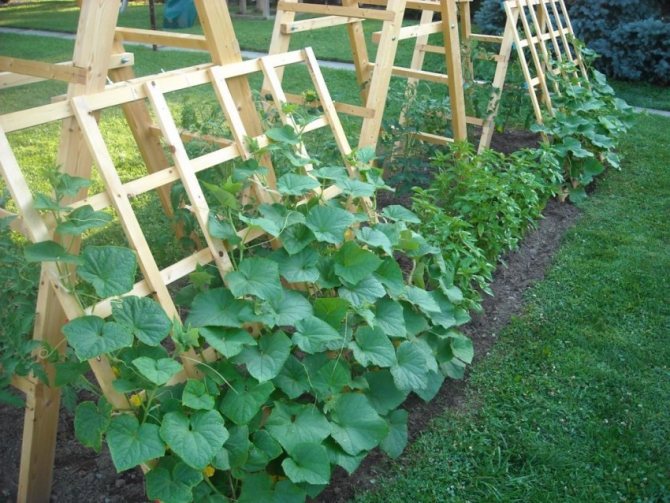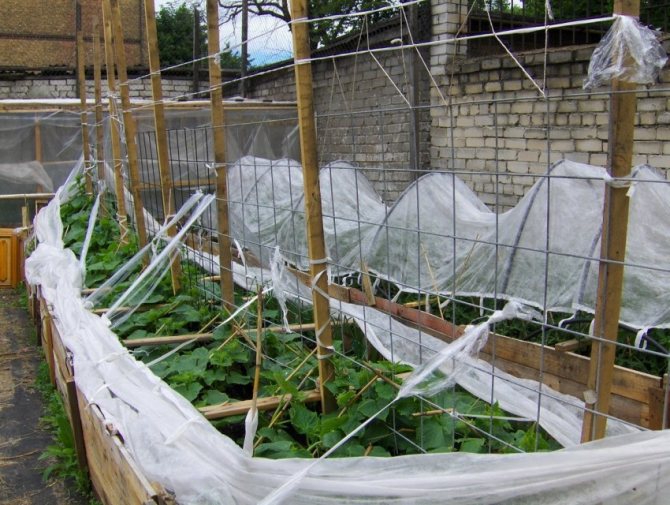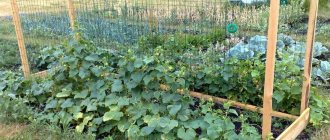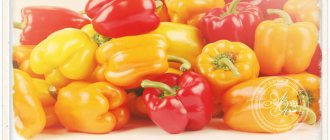Cucumber is distinguished from other melons and gourds by a tenacious mustache and a large number of thrown lashes. If you tie up cucumbers correctly, they will delight you with long fruiting and a good harvest.
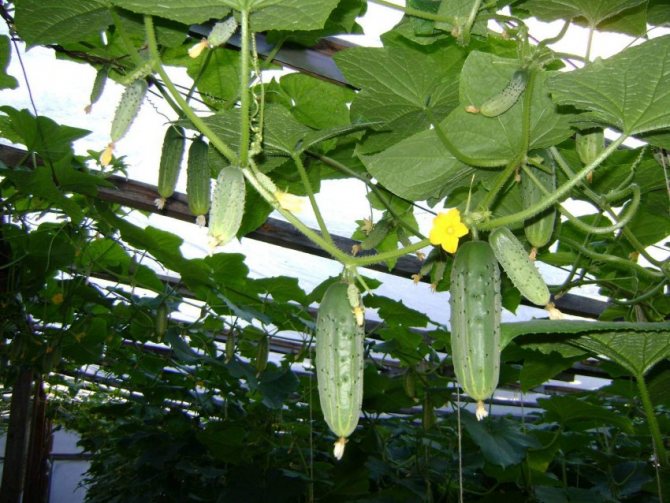
In the open field, the lashes fill the entire space, intertwine with the grass, and form a dense carpet. The yield of wild cucumbers is small: under a dense carpet, the roots of the plant are dull, flower stalks are less often formed, not all of them are pollinated.
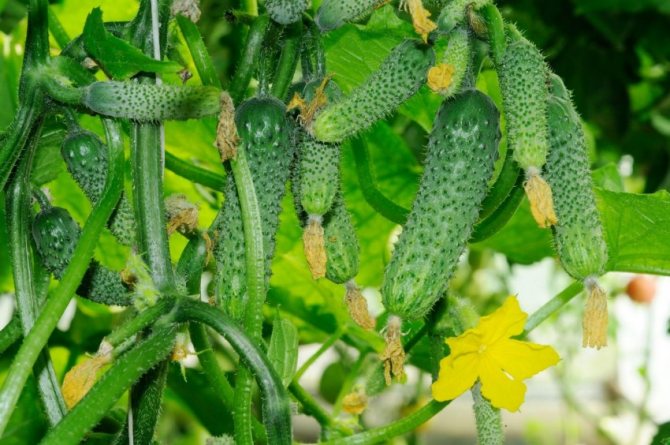

Fruits under the leaves are difficult to find, they overripe, become bait for slugs, and begin to rot on insufficiently loose soil.
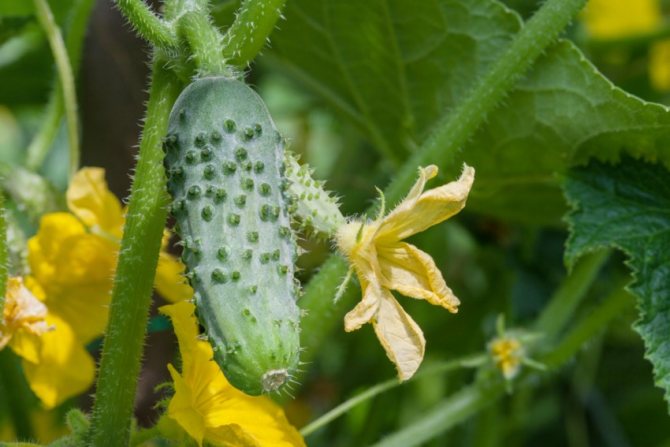

When to start a garter
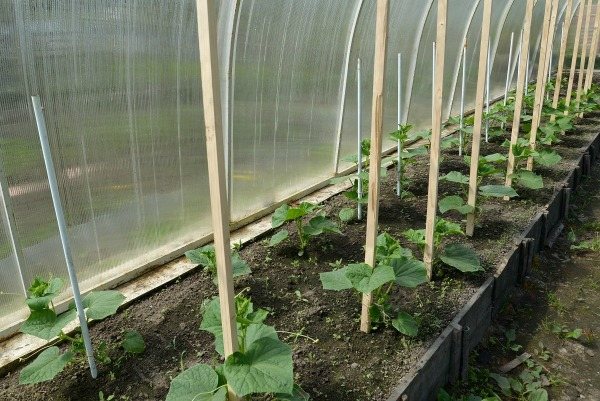

Cucumbers begin to tie up when their lash reaches a length of 30 cm. By this time, the plant has time to form 6 main leaves. If you are a little late with the garter, then there will not be much damage, just the lashes of the plants will be rougher, their flexibility is slightly reduced. As a result, cucumbers can be damaged, or even break.
Usually, the tying procedure begins to be carried out a month after transplanting the seedlings into the beds.
All the necessary materials and tools should be ready by this moment: the pegs are driven in, the horizontal ropes are stretched.
General rules
- What materials to use.
The best material for tying a cucumber is soft fabric ribbons (cotton, linen, knitted) from 3 to 5 cm wide and up to 25 cm long. At the same time, they must be strong enough, since the plant with fruits will have a significant weight. It is better not to use materials that are capable of stretching and spilling.
To tie to a horizontal support, you will need soft linen twine or long, strong fabric bands.
The material used for the support device is metal wire, mesh, strong rope, wooden bars, and poles.
- When to tie.
The garter begins when the plant reaches 35-40 cm. By this time, the cucumber will have 4-6 true leaves and will be independently held in an upright position.
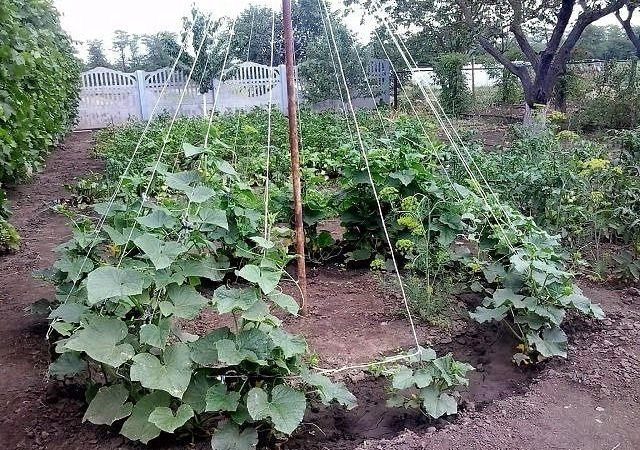

Materials for garters of cucumbers in the greenhouse
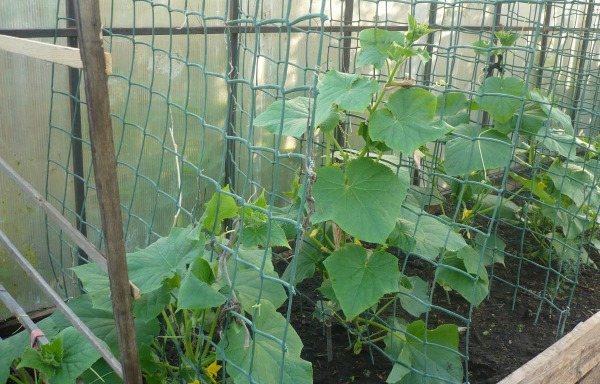

When tying cucumbers, it is very important to choose the right inventory correctly:
- Wooden or iron supports;
- A knitting wire that does not sag when pulled;
- The mesh is metal or plastic.
The binding material must in no way damage the fragile cucumber stems. Wire or fishing line are not suitable for this, it is better to opt for wide strips of fabric, rope. They support the whips more carefully, prevent injury. The knots are not tight and the strips are left without too much tension.
Also, when growing cucumbers in polycarbonate greenhouses, they also use other garters:
- Twine, cord... Synthetic polypropylene cord is very practical and comfortable. It is very moisture resistant, extremely durable, inexpensive. It can be used for horizontal splint, for garters. When working with the cord, you should be careful, as it is a little rough for cucumbers. The fibers of the cord, once in the soil, do not decompose.
- Trellis. This is the name of the strong steel wire stretched along the rows at the very top of the greenhouses. With the help of studs, it is attached to the elements of the structure base.
- Jute cord. Twisted from natural fibers, environmentally friendly. Once in the ground, its fibers decompose over time. Jute cords of various thicknesses are used for garters. When moisture gets on it, it swells and partially loses its strength.
- Grid. Modern technology suggests stretching a sparse net with cells of about 20 cm vertically next to the seedlings. The convenience of this option is obvious: tying can be carried out both horizontally and vertically. It is very convenient to fix side shoots on the net.
Along with the basic equipment for tying, you can additionally purchase other useful devices: stem holders, latches, flexors. Before starting work, all tools must be disinfected with chlorine solution, or simply scalded with boiling water.
What needs to be prepared in advance
The list of materials that will be needed for the manufacture of the structure depends on the chosen method of tying, the capabilities of the gardener and the characteristics of the site.
Basic materials for popular types of tying:
- metal or wooden posts;
- twine or other strong rope;
- strips of cotton fabric;
- metal or plastic mesh;
- arched arcs;
- scissors.
To help summer residents in gardening stores, there are special clips for fixing the plant. And for large-scale farms, a stapler will be useful, which is charged with a garter belt.
How to tie cucumbers correctly


- The twine, attached to the trellis, is lowered to the bottom of the cucumber. Having made a free loop, they grab the stem under the lower leaf with it.
- The twine itself is wrapped around the stem of the plant.
- The upper end with a margin of 20-30 cm is fixed on the wire.
- The loop at the bottom of the stem is made free, they do not tighten too much, since with the growth of a cucumber, its stem will thicken. Tugging on the stem will impede the supply of food, and this will cause the death of the plant.
It is also unsafe for cucumber and strong twine tension. Trellis vibrations can rip crops out of the ground. Tying is carried out in a light, almost free stretch, and the regrown lash is gradually wrapped around the twine.
Very often in greenhouses, when tying a crop with horizontal twines, the first sliding loop is put on the stem near 2 or 3 leaves.
Sometimes the twines are fixed with stakes placed near the planted bushes. The height of the peg should be about halfway up the twine. The stem is supported by wide ribbons tied to stakes.
When the plant reaches the first twine, it is convenient to grab it, then the pegs can be removed, since then the cucumber will independently develop and cling to the twine with its antennae.
Reasons for tying
The main reasons why tall cucumbers need to be installed for them on the beds are the following:
- thanks to the garter, the bushes are formed correctly, their fruiting increases significantly;
- competent strengthening of culture will allow the vine to develop more actively, new inflorescences and ovary will appear on the shoots;
- tied cucumbers that fall ill with an infectious disease will not infect other plants with it, because their stems are on different supports and do not contact each other;
- the appearance of such cucumbers is much more aesthetically pleasing than liana-shaped stems spreading on the ground;
- the garter makes it possible to save space - due to the vertical arrangement, the culture does not take up much space, which makes it easier to care for it, makes it possible to freely pick off the fruits;
- in the open field, the fruits grow to impressive sizes, under their weight the branches will break and be damaged, which threatens the death of the vegetable.
Garter methods
By tying cucumber bushes in greenhouses, vegetable growers come up with various options that are most convenient for them and for the plants in this greenhouse. The most common are 3 classic ways.
Horizontal way
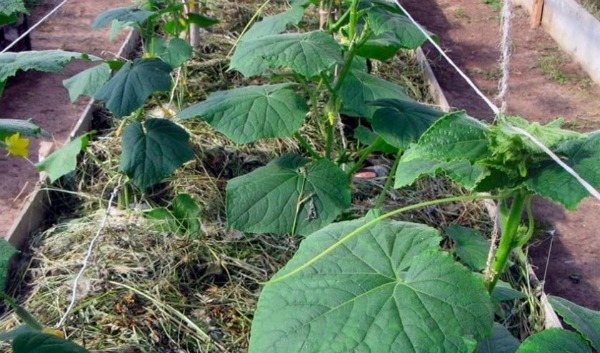

Such a garter is the simplest and most demanded. It is convenient because it can be carried out in greenhouses with low ceilings.
The construction looks like this:
- At the beginning and at the end of the bed, props made of wood or metal are installed.
- A strong twine or knitting wire is pulled between them so that there is no sagging.
- The first line from the ground should run at a height of 25-30 cm.
- All subsequent lines are located at intervals of 30-35 cm.
Instead of horizontal strings, nets are sometimes installed. This significantly increases the strength of the structure and is inexpensive. When the cucumber in the greenhouse reaches the desired height, the main stem is fixed with tape around the twine. If necessary, the side shoots are also fixed.
When making a horizontal garter, the crown of the leading stem must be pinched so that the bushes are formed correctly.
Horizontal tying, as a rule, forms low bushes, which are more extended in breadth than upward. When cucumbers grow, it becomes a little more difficult to care for them, and harvesting is not very convenient.
Vertical way


This method is good for polycarbonate greenhouses with high ceilings from 2 meters. With vertical garters, the plants are provided with the maximum amount of sunlight.
- The basis of the structure is a wooden or metal beam, located and securely fixed under the very ceiling of the greenhouse.
- Another beam serves as a ballast, an anchor for the entire structure and is located on the ground.
- Strong ropes and wire are pulled between the beams.
- The distance between the stretches is equal to the distance of the planted bushes. That is, each cucumber bush is entitled to an individual rope, which, as it grows, it will twine around.
When holding a vertical garter, pinch the top of the plant when it reaches the level of the upper beam to slow down growth.
Hybrid way
A mixed tying method is used for circular plantings. It is carried out as follows:
- A dozen metal rods are driven into the soil so that a cone is formed.
- A mesh is pulled over such a frame.
- In the first cells, the mustache of the cucumber needs to be tucked in, and then he himself will braid the entire pyramid.
This design is installed before the plants are planted.
Using mesh and wireframes
Square or rectangular coarse meshes are placed vertically between the supports, or installed at an angle of up to 60 degrees.
It is convenient to fix the mesh along the walls of buildings on the south or south-east side. It turns out a multifunctional decorative wicker: beautifully and the cucumbers are ripening. The growing branches are weaved between the metal rods, guiding the whiskers towards the wire.
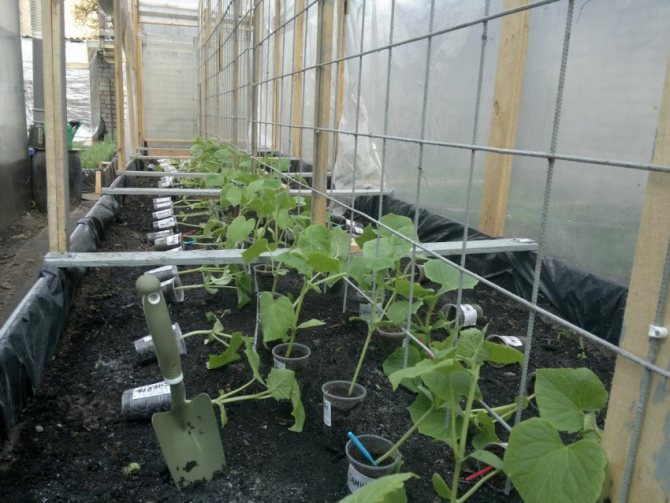

You can use the frames of film shelters for garters: arcs are installed over the rows, a strong twine is attached to them. The height of the arches is usually small, which creates inconvenience. Sometimes long supports are additionally stuck in the arches, the upper branches are tied to them.
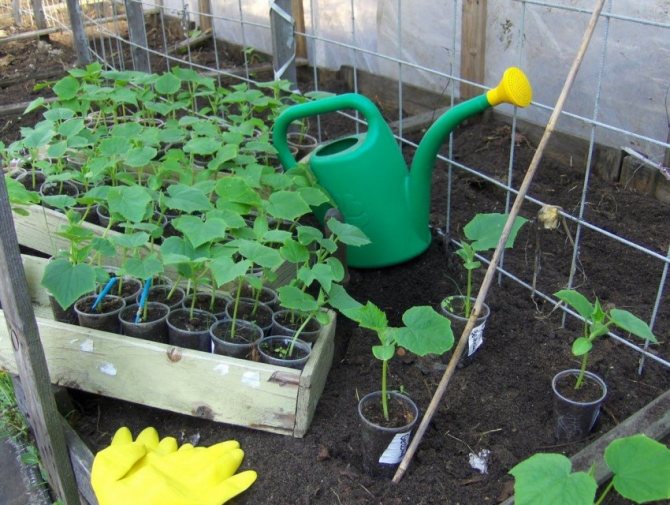

Cucumber bush formation
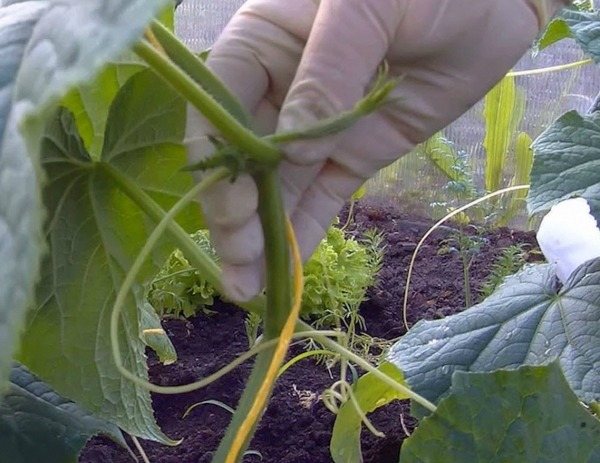

In order to significantly increase the yield of cucumber and the duration of its fruiting, it is necessary to form a bush. The most common option for growing cucumbers in polycarbonate greenhouses is the formation in one stem. Also, this method is very convenient for all parthenocarpic hybrids and varieties.
The root system of the plant cannot fully provide food and water to the numerous ovaries of zelents. Vegetable growers must remove all excess ovaries, leaves, stepchildren. This is done at the very beginning of their formation, until they have taken food from the plant.
One-stem formation is quite simple to perform, if you grasp the very essence:
- On the main whip, leave 2 cotyledon leaves and 3 full leaves following them.
- Everything else that is found in this area is plucked out: nascent whips, female and male flowers.
- If the seedling is slightly weakened, then a similar procedure is carried out up to level 4, or even 5 leaves.
- In the interval until the next leaf, all flowers are left. The existing side lash is pinched into 1 knot: the first leaf and the nearby flowers remain.
- The next leaf also has all the flowers, but the side lash should be pinched by 2 knots.
- All further lashes are pinched at the level of 3 knots.
- When the top of the main stem grows half a meter higher than the last trellis, it is simply wrapped around it.
Blindness
The authors of the "Dazzle" method noticed that when the vegetable lashes grow uncontrollably, the volume of the crop decreases.
Side shoots that diverge from the main stem should be removed to prevent overgrowth. This method will prevent depletion of the vegetable crop and increase yields.
The method can be applied both for a greenhouse and for a vegetable garden. The garter order with Blind is as follows:
- Attach the cucumber stem to a dug or tied support.
- After that, cut off, starting at 0.5 m above the ground, the lateral tendrils and shoots. As a result, the plant will give all the nutrients to the forming cucumbers, and it will also hurt less.
- After pruning, tie the bush with a leaf located at the very bottom of the stem.
- Fertilizing cucumbers with ammonia: using fertilizer
- How to deal with ants in a greenhouse and get rid of insects
- Salad with frozen, pickled or smoked mussels - step by step recipes with photos
Tips from experienced gardeners
Experienced vegetable growers are always happy to share their knowledge and skills with less experienced colleagues:
- Some cucumber varieties are prone to overgrowth. Due to this, their lateral shoots grow very long. After a while, they begin to braid the main stem, oppressing and injuring it. Such shoots require a separate garter.
- You should not let the cucumber crop outgrow the 2 meter mark: the upper shoots shade everything below. The top is necessarily pinched, and they begin to engage in lateral shoots.
In order for the self-tying procedure to be beneficial, it is very useful to familiarize yourself with some important subtleties from experienced gardeners:
- If the cucumber seedlings have not reached a length of 30 centimeters, you should not engage in a garter.
- Supports must be set up only before planting seedlings.
- It is best to tie the stem starting from the 3rd leaf. Even with your fingers during this period, you can not press the whips, so as not to disrupt the sap flow. The nodes should be all the more free.
- To improve the development and growth of seedlings, high lashes should be cut at the height of the garters.
- When formed in 2 lashes, the most powerful and healthy shoots are selected.
- It is undesirable to use metal structures for supports. Oxidizing over time, they become harmful to cucumbers. Better to use wooden structures.
- You should also abandon the plastic slats, which often do not withstand a serious load. Plastic pipes have proven themselves quite well, but they must be buried deeply for reliability.
- The best material for tying is garden ropes, fabric strips, twine. Clips and clips can be cut out of plastic bottles yourself.
- To reduce the load on the supporting beam, it is advisable to place the supports at intervals of one and a half meters.

